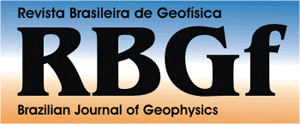A paleomagnetic study was performed on the Late Paleozoic Floresta Formation (Santa Fé Group) of the Sanfranciscana Basin, central Brazil. Thirty nine individual sites were sampled throughout a ten meters section near Santa Fé de Minas city. After detailed demagnetization procedures a unique characteristic remanence component was identified which was carried by both magnetite and hematite. Considering the indication of a previous investigation that hematite was formed during the initial stages of diagenesis it is concluded that magnetization is primary. This characteristic magnetization direction is of reversed polarity as expected for remanences acquired during the Permo-Carboniferous Reversed Superchron (PCRS, 260-315Ma), and the mean inclination indicates a paleolatitude of 44ºS for the sediment deposition. The corresponding paleomagnetic pole is located at 326.0ºE 62.0ºS (alpha95 = 5.1º; k = 23), and the age interval (260-280Ma) is constrained by the normal polarity events within the PCRS.
Paleomagnetism; Permo-Carboniferous; Sanfranciscana Basin







